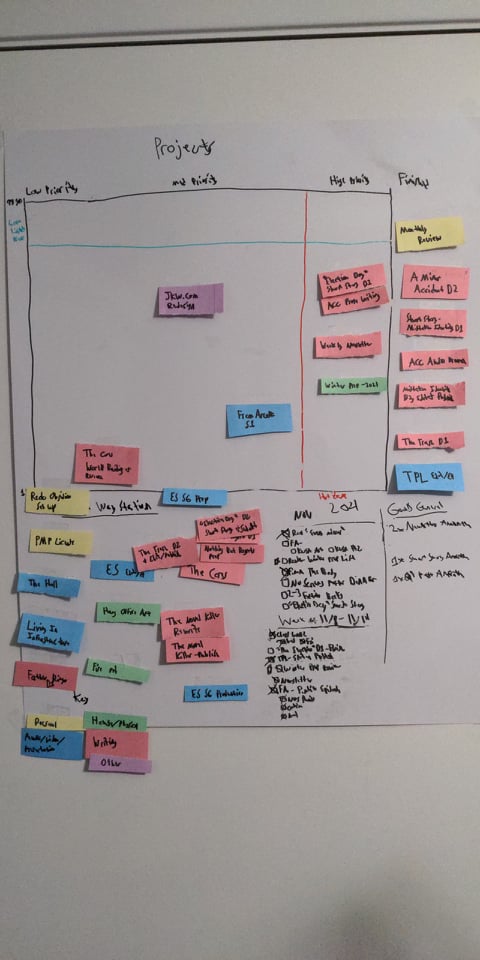Table of Contents
Intro
There are more ideas than time. This is something I struggle with a lot. I have a huge list of project ideas, and yet I know that I’ll never be able to complete – nevertheless work on – all of them in the time that I’m given here. Not to mention all of the time that is filled by other aspects of my life, from professional work, chores, sleep, the list goes on. If you’re anything like me you probably feel the same way. And if you’re really anything like me then you know that there are values of yours that you absolutely won’t compromise on, no matter what.
Managing all of these projects with so little time is and always will be a work in progress, but I’ve found a system that fits my brain pretty well and could serve as inspiration for you. It goes down to three things: defining values, flexible prioritizing, and tracking data.
Defining Your Values
The first thing you should do is define your values. These can be anything, but I prefer to use one-word descriptions for mine. Defining your most important values can put perspective on who you are and what really matters to you most. A couple of years ago I wrote down my values and they’ve stayed pretty consistent since then. For example, my values are:
- Health (physical & mental)
- Growth
- Maintenance
- Career
- Creativity
- Finances
- Relationships
- Community
- Fun
- Ethics
After defining your values reflect on your list. Give it a few moments, days, weeks, whatever time you need, and then when you return pick the most important ones to you, it doesn’t matter how many. These are your uncompromising values, the things you put above all else. For me, they are health, relationships, growth, and creativity. These are the values that whenever they’re pitted up against anything, you should do your best to uphold as well as you can. Use your list of values, especially your uncompromising values to define how you ideally want to spend your time and energy. This brings us to flexible priorities.
Flexible Priorities
A few months ago a book came into my life. A book that, within an online community I’m a part of for fellows like me who feel like that they have more ideas than time, is the most recommended book in said group. The book is called Refuse to Choose! by Barbra Sher. The book is written for people like me, people who have so many ideas and interests that they feel trapped by time and maybe overwhelmed by the sheer number of things that they want to do. There are a lot of useful pieces of advice in Refuse to Choose! and you can hear my talk about the book extensively on The Productivity Lab’s review of the book, but the thing I want to talk about here is the “rotating priority board.”
A rotating priority board is exactly what it sounds like. It’s a board (or an app) that lets you organize your projects or tasks by priority. It can be a grid with each square ranked by priority, it can be a kanban board or even a calendar. It’s whatever works best for your brain. For me I found that my brain works best with two axes: one for priority level, the second for percent complete (which we playfully called Kyleban Boards over at The Productivity Lab).

It doesn’t matter what it is, the most important feature is it should allow you to manipulate your priorities and rerank them whenever you so choose. Just having this visual representation of all of your projects and which ones need to be focused on the most works wonders at putting your ideas into perspective, and with the ability to move things around you can decide one day to say work on a novel, and the next day to work on your garden. The next section of this post is a very me thing, but I think it’s just as important as anything else: tracking your data.
Tracking Data
I’m an engineer, no matter how many stories I write, podcasts I host, or blog posts on productivity I compose, I will always be an engineer first. Because of my engineer first mindset the thing that always motivates me and helps me make better decisions is gathering as much relevant data as I can on my goals. [1]As I write this blog post I have a Toggl timer tracking how long it’s been, surprisingly it’s been an hour since I first started writing this to get to this point. Writing always takes … Continue reading
I believe that this tracking philosophy is useful to everyone. You don’t have to be as intense as I am with tracking time, word counts, exercise, and many other facets of your life, but just track anything that is meaningful towards your projects or values. Having the right data can not only tell you where you’ve been but help you make better decisions on how to get where you want to be. Since this is supposed to be a post about how you can manage your ideas and time and not about how I do it I won’t get into details, but if you’re curious you can see my previous post covering my tracking and reviewing system titled My Monthly Review.
For some inspiration below is a list of tools you can use to track your stats:
- Toggl – Time tracking, the free plan is all you need unless you’re a freelancer.
- Forest – A pomodoro plugin and smartphone app that “grows” a virtual tree for every session you have.
- YNAB – Budgetting and expense tracking.
- Exist – A mood tracking app that takes in aggragate data from other tracking apps to see how your activities correlate with your overall mood.
- Daylio – Another mood tracking app. This one is a little more manual than Exist, but works just as well.
- GoodReads – A social media site for tracking books. I use it to track my reading. It is owned by Amazon and if you have concerns about Amazon tracking your data there are a few alternatives out there.
- Google Sheets – For building custom spreadsheets. I use one for my daily word count, and another for my daily review. [2]One of these days I’ll write a post about my daily review. It’s such a convoluted system built exclusively for my brain that I feel like it’ll be hard to explain. But that’s a … Continue reading
What matters is that you gather the right data needed to know if you’re fulfilling your goals. Maybe tracking isn’t for you, and that’s fine. I just suggest it for people like me who need numbers to reaffirm how far I’ve gotten and plan for the next step.
Where To Go From Here
This post is just one example of how to manage your priories, but the thing about the productivity world is that each of us is different. Maybe you have a brain that just hates everything about my system and will reject everything I say. That’s fine. This post is written to help inspire you to make the informed decisions you need to build your own systems. There are no solutions, only tools. We all have a limited amount of time in our days, weeks, months, years, and life, and as productivity nerds, it is our job to find the right ones that fit our lives the best. Stay productive my fellow project-a-holics.
References
| ↑1 | As I write this blog post I have a Toggl timer tracking how long it’s been, surprisingly it’s been an hour since I first started writing this to get to this point. Writing always takes longer than I expect it to take. |
|---|---|
| ↑2 | One of these days I’ll write a post about my daily review. It’s such a convoluted system built exclusively for my brain that I feel like it’ll be hard to explain. But that’s a problem for another time. |
